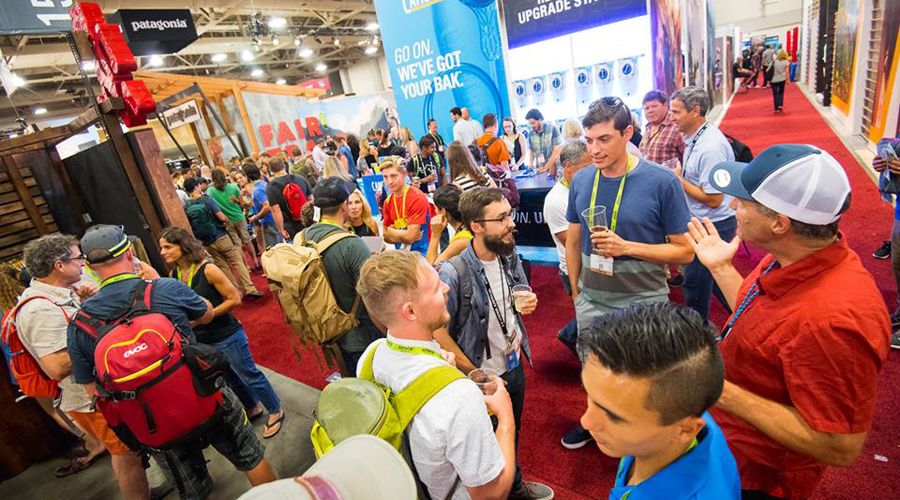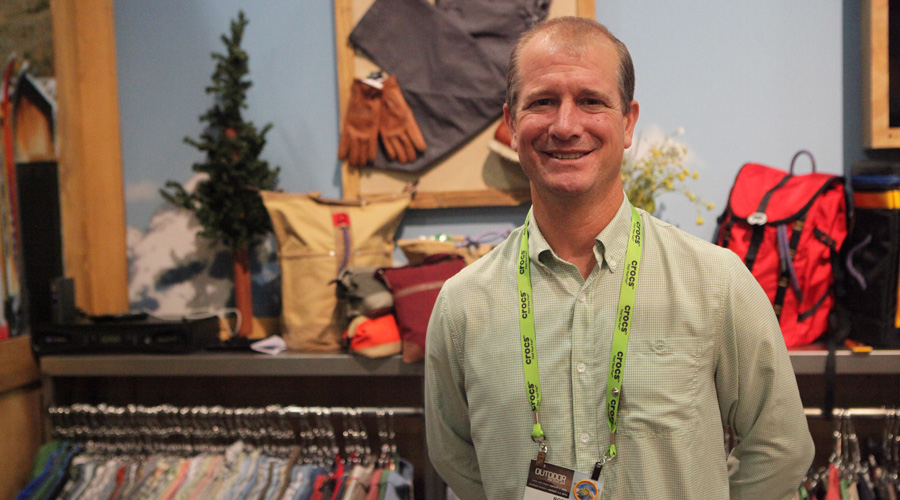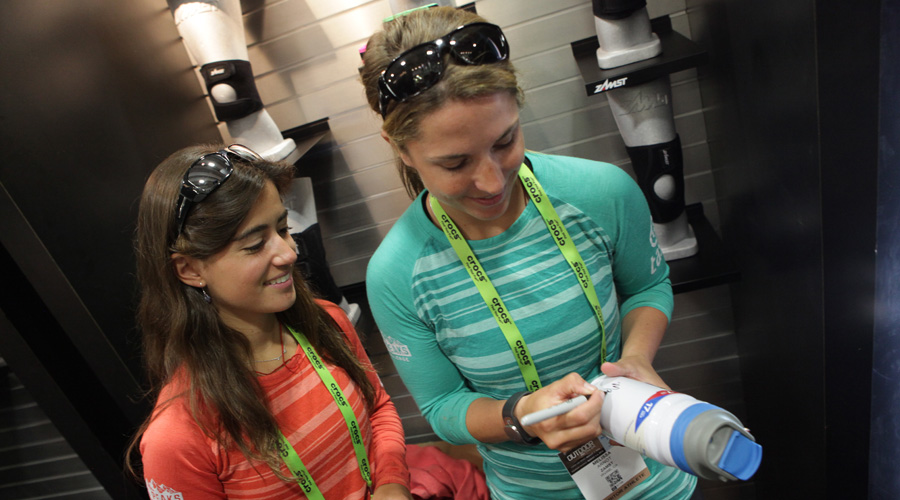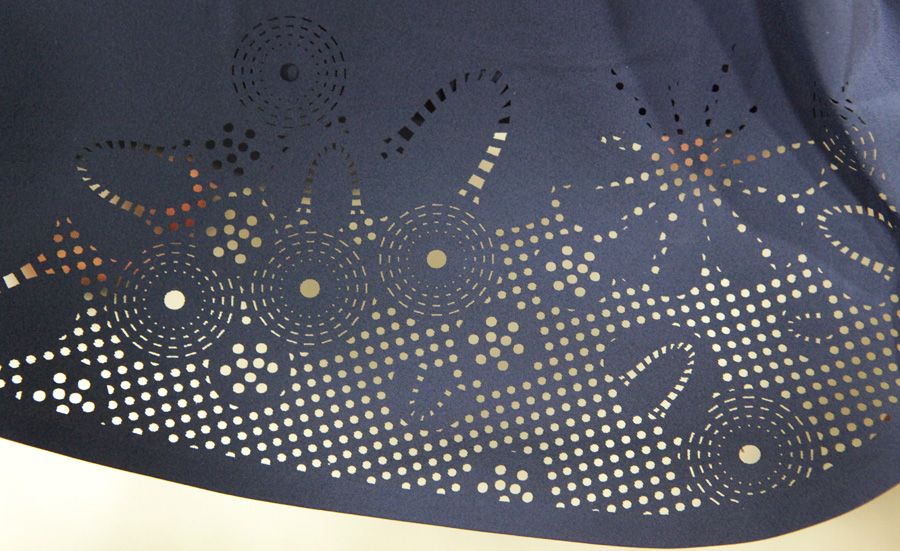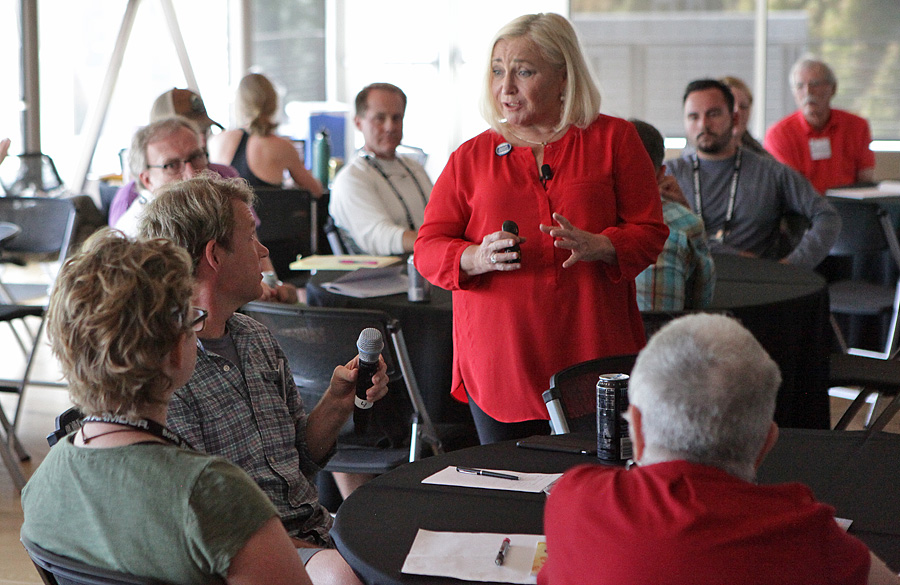By David Clucas and Thomas J. Ryan
A welcoming surprise, Outdoor Retailer Summer Market 2016 was busy, upbeat and optimistic.
Despite several major U.S. active-lifestyle retail bankruptcies and a mild winter that hurt the holiday season for many retailers — plus, the expected glut in inventories to follow both — the industry came out in full force to Salt Lake City this week.
The consensus is that while some retailers failed, it wasn’t for a lack of consumer demand in the space. Rather, it signals a significant shift in where the consumer is fulfilling that demand.
“If you look at outdoor retail as a big, long bridge and on one end is Walmart and on the other is your store (specialty retailers), the middle has fallen out,” Grassroots Outdoor Alliance President Wes Allen told retailers at a preshow event. “And you can take some of that business. Now is the time to strike.”
Most retailers at the show told us that they have yet to see the negative effects of those going-out-of business sales. But that doesn’t mean the industry is in the clear, they cautioned. Many added it will take more than a year for things to clear out, and bigger aftershocks may be on the horizon as inventory slated for those defunct retailers continues to arrive from long-lead-time manufacturing.
Vendors, too, face concerns. Some are licking their wounds after getting snagged in the bankruptcies. Others are likely to get hit come the fall/winter buying season, when they’ll see the real effects of last year’s winter — e.g., retailers placing smaller orders with plenty of leftover inventory in stock.
Given the overall challenges facing retail, many dealers told SGB they have become more sophisticated around inventory management and relying more on fill-in orders. The local independent retailer also continues to face challenges competing against the e-tailers, with a selling message focused on price.
The upbeat attitudes by many dealers and their ability to navigate the challenging climate was seen by many as a sign of the health for the specialty model as a differentiator in the marketplace.
“I think there’s a ton of energy at the show,” said Todd Spaletto, president, The North Face. “The first two days have been just really packed and the energy is high. I think what’s really exciting when I’m talking to a lot of our specialty dealers is that they are really focused on the experience of their stores and the connections to their communities. The ones that are referencing business being strong and are optimistic about this year, next year and beyond, they’re just developing a deeper relationship with their town and their community; they’re creating experiences around the product, and I think they’re really defining specialty retail.”
Spaletto added that many of the recent retailers in the news headlines focused more on “selling stuff” in their stores rather than engagement, and that partly led to their struggles.
“I think the traffic was really steady,” said Chris Miller, VP of sales, Vasque. “The first two days have been a huge success.” He echoed the sentiment that dealers appear to be “extremely positive” given the challenging conditions with bankruptcies and a tough holiday season. Also creating some concerns for both vendor and retailer is the potential mega-merger of Bass Pro and Cabela’s.
“Then when you throw in the election in November, there’s a lot of uncertainty that’s taking place,” said Miller. “But the reality is the economy is strong, the weather has been fantastic for most parts of the country this year and people are outdoors way more than they’ve ever been before. So our industry is in a good position.”
Fred Clark, CEO of Thule, noted that the outdoor industry is clearly more upbeat and “seeing more opportunities” than the bike channel. Overall, he sees retailers and dealers focused more on inventories, which tends to lead to slower orders initially and more fill-in scrambling for vendors. But he feels it’s healthier overall for the marketplace.
“Guys are just looking to run their business tighter and are just trying to be smarter,” Clark said. “That’s not bad.”
“Our show’s been great,” said Mike Barker, head of product development at NRS (Northwest River Suppliers). “I was commenting to someone yesterday that every year the show organizers say attendance is up and you’re like, ‘Yeah, right!’ But this year I’d say I think they might be right.”
“This is my 38th show and yesterday was the busiest I can remember for an opening day,” said Jordan Campbell, communications manager, Marmot. “I had people crashing the booth asking a lot of questions about programs we have going on. So you could feel the intensity and excitement on the floor.”
Helping Specialty Survive
Similar to what we heard at the Grassroots Summit in June, brands are doubling down on specialty retail as big names in the middle market went bankrupt and liquidated this summer.
“I think specialty is one of the few places in the market that isn’t over-retailed,” said Mountain Khakis President Ross Saldarini. “Regional players are making acquisitions and growing. And they are well located on the main streets of America where today’s consumers are returning to shop. Nobody wants to go to the mall anymore.”
Despite some criticism from retailers of MAP policies, or more specifically their enforcement, Saldarini said he sees them as vitally important in today’s online world, and agrees that brands — and retailers — would need to step up policing of MAP.
Saldarini also likes the avenue Locally.com is providing, helping brands and retailers match local inventory to consumers. When a customer searches for product on Mountain Khakis’ website, for example, a button gives them the option to find the product in their area, view available inventory and then buy it at the local store. It saves on shipping and gives local retailers the sale.
Over at the Ruffwear booth, Director of Sales Dove Gibson was excited to talk about the brand’s Latitude program, which allows retailers to make wholesale orders throughout the year when they need to with free two-to-five-day commercial-ground shipping for $99 a year. She compared it to Amazon Prime and said it reduces the inventory risk for both the brand and retailer.
“Pre-season ordering doesn’t actually give us a good picture,” Gibson said. “We have better historical data. Let us handle the forecasting and order when you need to. Getting retailers to do business with us six times a year instead of two is also great for the relationship, keeping conversations going year-round.”
Sustainability Driving Differentiation
While “going green” and pursuing sustainable business practices have always been staples of the outdoor industry, there seemed to be a renewed push toward the efforts this OR Summer Market — in large part to differentiate outdoor products (and place them at a higher level) from the abundant active and athleisure wear in the marketplace.
In these cases backstories are key, brands told us, and the sustainable story should begin at square one in sourcing raw materials.
Take newcomer skateboard brand Bureo, which worked with the Chilean government to set up fishing-net disposal points in 15 of the country’s coastal communities. The nets often get discarded in the ocean, contributing to roughly 10 percent of the plastic pollution problem in the waters. Bureo takes the old nets, chops them up and recycles the plastic to make boards.
“We own our whole supply chain from start to finish,” said Co-Founder David Stover. “It’s a durable, long-lasting product… and even after their lives as skateboards, we’ve pledged to take them back and recycle them again.”
Back To The Core
Vendor executives also acknowledged the need to clean up distribution channels and SKUs.
While many brands continue to expand their outdoor lifestyle offerings, there’s also a push to pull back a notch to a brand’s core. That doesn’t mean every brand has to make extreme gear for Mount Everest, said Fjallraven North American President Nathan Dopp. Rather, they need to remain focused on who they are as a brand.
At Black Diamond, after years of rapid expansion, acquisitions and offshoring — plus the troubles those decisions came with — the brand is pulling back to its core of climbing for the spring/summer season across its apparel and hardgoods lines. That means, for example, no more Black Diamond hiking packs, and on the flip side, an expansion into climbing ropes and kids climbing helmets and harnesses. Despite the pullback, Black Diamond will keep its headlamp and trekking pole products, which remain the brand’s top two sellers.
We heard a similar tune at Mountain Hardwear, where President John Walbrecht and Global Director of Product Merchandising and Design Robert Fry told media at a luncheon that the brand had lost its vision in the fog.
“If we don’t make the lightest gear or we don’t make it the most durable or most premium, we’re not going to make it going forward,” Walbrecht said. “Let’s do things we should, not things we could.”
Back at Fjallraven, Dopp also pointed to efforts to clean up distribution channels as retailers complain about so-called “grey market goods” — e.g., a brand’s product showing up in Costco through a third-party distributor.
“I’ve closed millions of dollars in distribution in the past six months, and it’s painful, but the right thing to do,” Dopp said. “We have to take a long-term view for the health of the brand.” Most of the channels being cut off were online, non-brick-and-mortar and difficult-to-verify distributors, he said.
Versatility Reigns
While the core outdoor message was making a comeback at the show, the athletic and lifestyle push into the industry remains strong. The buzz word from many was “versatility” in response to millennials, who show a preference of enjoying a great number of activities — yoga on Wednesday, hiking on Thursday, Crossfit on Friday, etc. — versus becoming an expert in one.
“It’s not as much about carrying the 80-pound pack for eight days of suffering as it is about going out and getting it done fast, and then on to the next adventure,” said Jordan Wand, vice president, outdoor apparel at Under Armour. “What this notion of athleisure brought is that you can have performance, comfort and versatility. The key is making product versatile, without being generic,” Wand said.
Chris Lindgren, Under Armour vice president of footwear, outdoor and training, agreed and said millennial consumers are tired of having a quiver of products.
“It’s too much choice and too much money,” Lindgren said. “Give me one bike and a couple of shoes because other things — particularly experiences over product — are competing for my time.”
Women Rule
For all the flak the industry has received in the past for being too male-dominated, efforts to diversify are paying off as we see more brands not only manufacturing women’s products tailored to women, but increasingly employing and promoting women within their organizations.
There are plenty of female athlete role models, none trending bigger than Melissa Arnot who, this year, became the first woman to summit Mount Everest without supplemental oxygen (it was her sixth overall summit of Everest).
Arnot was at Outdoor Retailer in the midst of her latest challenge, summiting 50 of the highest peaks in every state in 50 days, along with guide-in-training Maddie Miller. The women had 46 peaks down and only four to go.
The Industry’s Crystal Ball
What’s to come in the outdoor industry? Talk to Cindy McNaull, brand and marketing director at Cordura. The fabric folks have at least two years of insight into what’s coming down the pipeline for the outdoor industry.
McNaull sees simplicity and style reigning high over the next few years — a driving trend coming from Japan. Ironically, she said, Japanese designers setting the trend are looking back to the U.S. for inspiration.
Cordura is known for its durable fabrics, so it’s no surprise that this remains a big trend from McNaull’s perspective. But here’s the new twist. “People want durability without the hard looks of durability,” she said. Softer looks, colors and touches are in style. Need an example to follow? Watch for startup Onu out of Iceland, she metioned, showing off one of the brand’s active skirts with a durable but soft and supple fabric, plus a creative laser-cut pattern design at the hem.
Outdoor brands better be ready for competition, she said, as there’s an influx of fashion brands scooping up performance fabrics to create designer, performance clothes — from suits to dresses and runway-worthy pieces.
Specialty Retailers Unite
Earlier in the week Grassroots Outdoor Alliance, Outdoor Industry Association and Outdoor Retailer partnered to bring several educational seminars for specialty retailers — no vendors allowed — called Rise.
Guest speaker and small-business expert Rhonda Abrams of Planningshop.com greeted retailers as “survivors,” saying they were the best of the retail crop that survived the past few years of attrition and were best positioned to succeed.
“Disruption is what someone does to you,” she said. “Innovation is when you do it yourself.”
She compared outdoor retail to the independent bookstore market which, unbeknownst to many, she said, has been growing over the past five years despite the rise of Amazon. Yes, she admitted, a lot of stores closed before that, but those remaining proved they were the best and are now reaping the benefits.
“The good news is that people want to be outdoors, people want the stuff you sell… even when they’re not outdoors they want to be dressed like they are… and they are enthusiastic about it,” she said. “And when they’re enthusiastic, they seek expertise and experiences.”
She encouraged retailers to focus on providing a niche to their customers — even more of a niche than outdoor. “Don’t be an outdoor generalist,” she said, “find your corner of outdoor — maybe it’s watersports or fishing — provide depth instead of breadth. You can’t be the middle to everyone.”
Every so often, retailers would break out into interactive sessions to discuss ideas that they have been working on, including what Abrams called “un-Amazonable” products and services — in other words, what online retailers and big box retailers can’t provide their customers. Same-day rental services, gear repair (one retailer had an onsite sewer on staff), hosting meet-up groups, vendor and pint nights and onsite gear demos were a few of the ideas that sprung up — all giving the customer a reason to visit the store beyond when they wanted to make a purchase.
The event’s second session on MAP (minimum advertised price) policies was hampered by logistical and technical issues — speaker Ryne Misso was unable to attend and phoned in via a sometimes choppy video conference connection — but the discussion was still lively, with many specialty retailers complaining vendor MAP policies were unevenly enforced. Examples included the vendors themselves violating their own MAP policies.
“MAP doesn’t work,” one retailer said. “The only way to talk to the vendor is about maintaining margin. So, if a margin doesn’t hold, my next conversation with them is ‘how do we get back to it, what are you going to do about it?’”
Next Up: OR Winter Market
While show officials will likely come out of Summer Market 2016 with their heads high, Outdoor Retailer Winter Market may be a tougher challenge.
The show’s earlier dates (right after the winter holidays) did not go over well with many attendees and an overall weak snow last season on the East Coast didn’t help. All this forced show officials to push back its previously planned dates for 2017 by a few days, plus shortening the trade-show portion to just three days for winter, now scheduled for January 10-12.
Photos courtesy David Clucas. Lead photo courtesy Outdoor Retailer.

